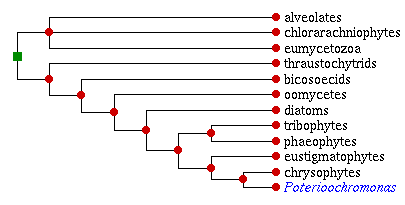Poterioochromonas is a small genus of minute golden flagellates. The ca. three species occur commonly in freshwater environments, especially lakes, ponds and bogs. They are "mixotrophic", able to grow in the dark on dissolved organic carbon (osmotrophy) or ingested food, usually bacteria (phagotrophy), as well as in the light via photosynthesis (autotrophy). Species of Poterioochromonas are frequently used in physiological research. Poterioochromonas belongs to a group of golden algae that botanists call "chrysophytes" and zoologists term "chrysomonads". In turn, the chrysophytes/chrysomonads belong to a large, presumably monophyletic assemblage of algae, fungi and protozoa that has been called "chromists", "heterokonts" or "stramenopiles".

Postulated global eukaryote phylogeny based on presence or (ancestral) absence of mitochondria, and shape of mitochondrial cristae. Poterioochromonas belongs to the tubular clade.

Postulated phylogenetic position of Poterioochromonas, inferred from molecular and morphological data. Branch lengths are arbitrary and do not reflect phylogenetic distance.
Return to summary information